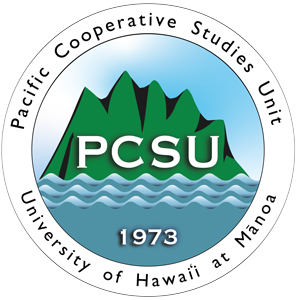** THIS PAGE IS CURRENTLY UNDER CONSTRUCTION**
Guide to Palm Pests & Diseases
Click any of the buttons below to jump to a particular section.
PREVENTION
The best thing to do is to maintain healthy palms!
- Select the right palm species for the right space.
- Check the climate, soils, spacing, and maintenance needs for your species.
- Give your palms space, about 8-15 feet apart generally and palm crowns should not touch.
- Make sure the soil conditions are right.
- Ensure well-draining soil and do not overwater.
- Nutrient deficiencies can be caused by poor soil aeration and high soil pH.
- Fertilize 2-3 times a year during the growing season.
- Use palm specific slow-release fertilizers with a 3-1-3 or 3-1-2 NPK ratio.
- Use correct proportions of nutrients so it is not harmful to plants.
- Adjust nutrient amendments depending on your soil conditions.
- Maintain the growing area.
- Keep grass, groundcover, shrubs, and weeds at least 2 feet from the trunk.
- Apply several inches of mulch around the base of the trunk. Be careful not to bury the trunk base under excessive organics as that can lead to rotting or other fungal issues.
- Be careful using herbicide near palm trees. Young palms are particularly sensitive, but mature palms can tolerate broadleaf herbicides like glyphosate and triclopyr.
- Mitigate wounding when pruning, cultivating, or harvesting.
- Use straight-edge manual saws and thoroughly disinfect blades before touching the next tree.
- Avoid chainsaws and tree spikes as they can spread disease-causing fungi, bacteria, and viruses.
- Don’t recycle infected or infested plant material for use as mulch because of potential pathogen and invasive species spread.
NUTRIENT DEFICIENCIES
Palms require a healthy mix of macronutrients nitrogen (N), potassium (K), phosphorous (P) as well as micronutrients like boron (B), magnesium (Mg), and manganese (Mn). These nutrients support vital functions within the palm such as photosynthesis, respiration, nitrogen-fixation, enzyme activation, gas exchange, and resistance to disease and other environmental stressors. So when there’s not enough of a nutrient, then the palm can begin to exhibit unhealthy symptoms and you will need to amend your soils to help your trees recover. The photos below show nutrient deficiency symptoms across different palm types.

(PC: Scott Nelson, UHM)
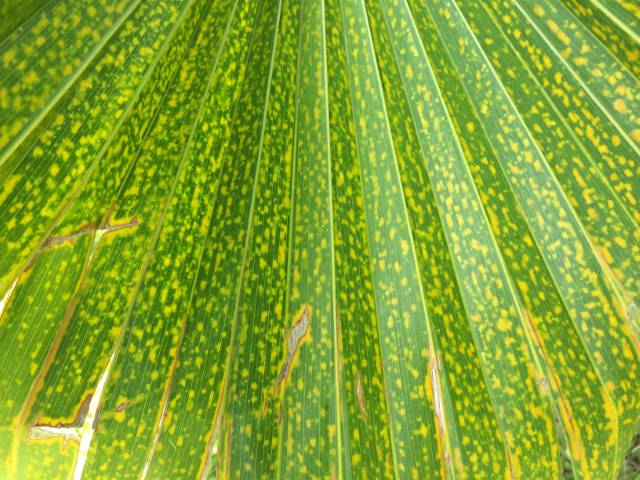
(PC: Scott Nelson, UHM)

(PC: Scott Nelson, UHM)

(PC: Scott Nelson, UHM)
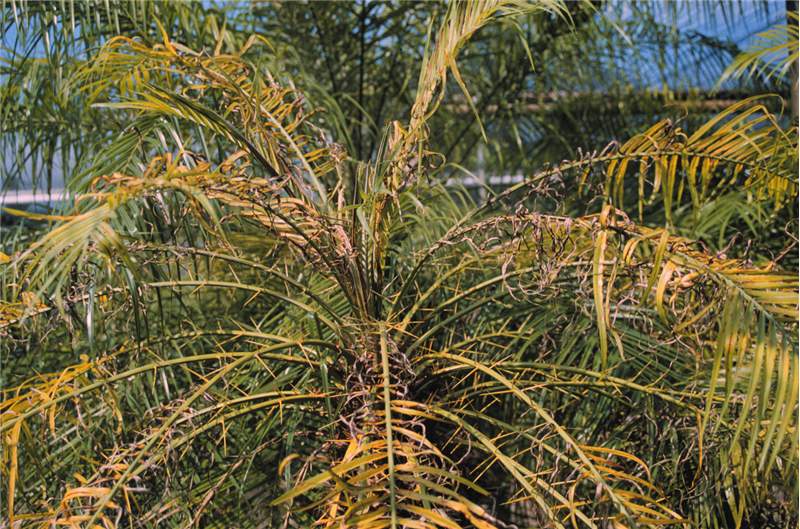
(PC: T.K. Broschat, UF/IFAS

(PC: Scott Nelson, UHM)
| Nutrient Deficiency | Affected Areas | Major Symptoms | Long-Term Impacts | Treatment |
| Nitrogen (More details) (Photo gallery) | Older leaves | Uniform light green fronds, growth rate slows, trunk tapers. | Usually not fatal unless container palms. | Fertilize soil with slow-release nitrogen. |
| Potassium (More details) (Photo gallery) | Older leaves first | Translucent yellow-orange splotchy dieback, necrosis at frond tips and margins, trunk narrows. | Can be fatal if not treated. Canopy appears frizzled. | Apply slow-release potassium fertilizer. Do not use herbicides near palms. |
| Boron (More details) (Photo gallery) | Younger leaves, worse at the frond tips. | Leaves usually remain green, but produce distorted or limited fronds. | Can be fatal if not treated. Crown may droop, fruit can abort, and foliage necrotic. | Apply boron product to the root zone. |
| Magnesium (More details) (Photo gallery) | Older leaves | Yellowing frond tips while leaf bases and midribs remain green. | Not fatal, but can take years to recover. Lower fronds may die early and canopy appears scorched. | Apply slow-release palm fertilizer with magnesium. |
| Manganese (More details and photos) | Younger leaves with more severe symptoms at leaf bases. | Uniform frond yellowing with necrotic steaks. | Can be fatal without treatment. Canopy becomes scorched, shriveled, and/or shrunken. | Apply manganese sulfate to the soil. |
| Iron (More details) (Photo gallery) | New fronds first | Fronds yellow while leaf veins remain green. | Cosmetic, not fatal issue. Trunk and leaf growth may be stunted. | Improve soil aeration, reduce waterlogging, and increase soil organic matter. |
PALM DISEASES
Palms in tropical Hawaiʻi can face many different diseases from fungal, bacterial, viral, parasitic, and even insect vectors. Some diseases are species specific, but most are related to a fungus or mold. If not identified early, diseases can lead to palm death. Sometimes the only solution is to remove the entire palm to prevent spread. The gallery below shows some of the more common diseases in Hawaiʻi, but there are more diseases out there.
To learn about the palm diseases not currently present in Hawaiʻi, please visit the following Plant Pono pest pages:

(PC: M.L. Elliott, UF/IFAS)

(PC: M.L. Elliott, UF/IFAS)

(PC: M.L. Elliott, UF/IFAS)
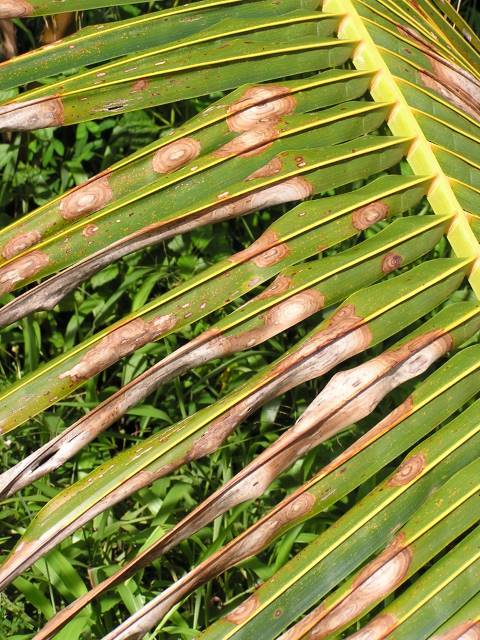
(PC: Scott Nelson, UHM)

(PC: Scott Nelson, UHM)
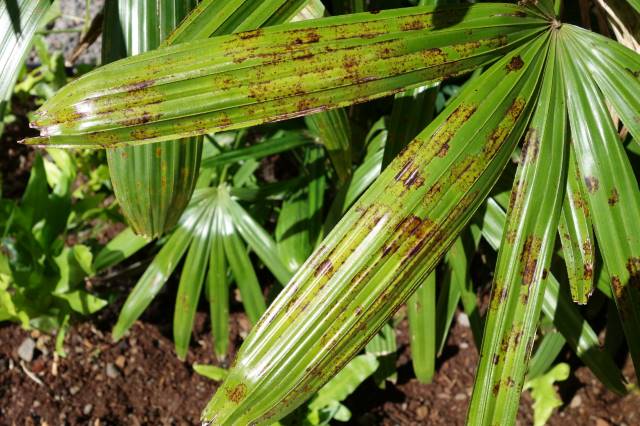
(PC: Scott Nelson, UHM)
| Disease | Affected Areas | Main Symptoms | Treatment |
| Phytophthora Bud Rot (More details) | Young fronds, common after long periods of rain. | Black lesions appear and fronds wilt, which can attract pests. Older fronds remain green for several months. Only the trunk will remain. | Prevent wet palm foliage by only watering around the base and giving palms ample space between each other. Once infected, the palm should be removed to prevent spread. |
| Thielaviopsis Trunk Rot (More details) | Older fronds first and usually on the upper half of trunk or just below the palm crown. | Fronds may wilt and become necrotic. Darkened and soft regions on the trunk might be visible. Stem bleeding sometimes occurs. Suddenly, the trunk will collapse at the infection site. | Water is required for infection, so minimize wet conditions. Plant at appropriate distances for good airflow and water in the early morning only when necessary. Remove any infected palms. |
| Fusarium Wilt (More details) | Specific to queen palm, Mexican fan palm, and Canary Island date palm. Affects older fronds first. | One-sided yellowing or necrosis leading to frond death. Distinct brown stripe on petiole and rachis. Palms can die within 2-3 months of first symptoms. | Always use disinfected tools to prevent possible contamination. Remove any infected palms and do not plant potential host palms. |
| Leaf Spots & Blights (More details) | Any age frond, but more common in younger palms. | Spots start round and grow into lesions with a contrasting halo. Colors can be yellow, brown, or black. Over time spots will merge and entire fronds can die early. | Difficult to verify fungal species visually. Best to prevent wet palm foliage. If necessary, fungicides can be used. |
PALM PESTS
There are many different pests that affect palms. Some are specific to certain species, while other pests are generalists. The best prevention for any pest infestation is to maintain good palm health because these insects are usually attracted to already stressed plants. Listed below are some common palm pests as well as species not known to be present in Hawaiʻi. We offer basic information on the species, associated damage, and control tips. To learn more, check out the linked resources with each palm pest.
Beetles
Beetles are characterized by their strong chewing mouthparts and a hard shell that protects their wings beneath. All beetles undergo a complete metamorphosis from egg to larva, then to pupa, and finally into an adult beetle. Beetles are most harmful when they are hungry larvae and reproducing adults. Some beetle larvae, like CRB, form C-shapes and look like traditional grubs with soft translucent skin, a brown head capsule, and a slightly enlarged abdomen. While the other type has a shiny hard skin and looks more like a worm with legs.

PLEASE REPORT IF SEEN:
Coconut rhinoceros beetle (Oryctes rhinoceros): Please check out our BIISC CRB page with all of the important information about this new invasive!
Currently known to be in Waikōloa, but we need vigilant community eyes to help report any suspicious beetles, grubs, and palm damage.
PLEASE REPORT IF SEEN:
Coconut hispine beetle (Brontispa longissima): This slender black and orange beetle feeds on unopened palm fronds. It is found in Southeast Asia, Australia, and some parts of the South Pacific and East Asia.
Damage looks like red-brown streaks parallel to the frond midrib. As the frond unfurls, streaks enlarge and form gray splotches. For more species information and to see associated palm damage, visit this Pacific Pests, Pathogens, & Weeds factsheet.

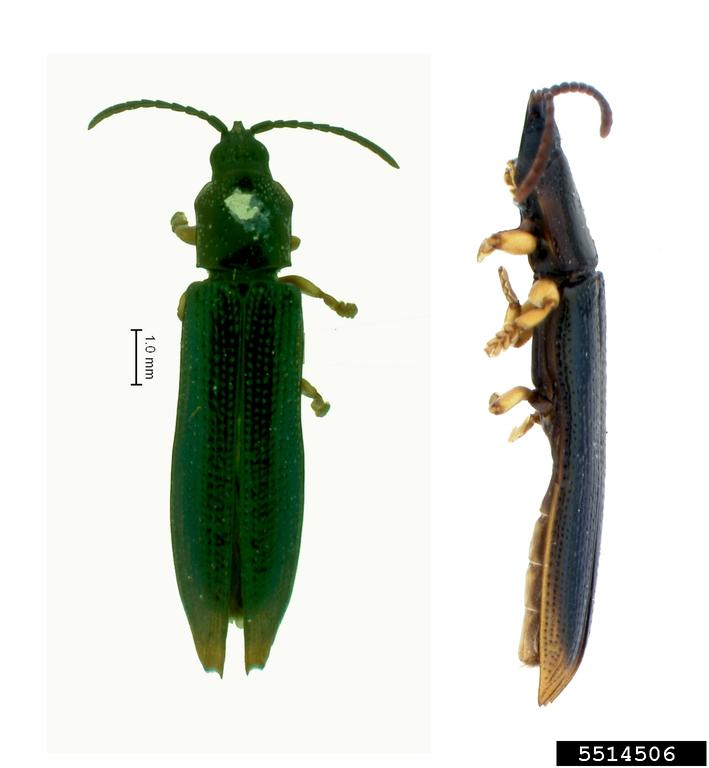
Blue coconut leaf beetle (Brontispa chalybeipennis): This slender dark blue beetle feeds on the young terminal leaflets of coconut, pandanus, and other palms. It was introduced to Hawaiʻi and can also be found in Kosrae, Palau, Pohnpei, and the Marshall Islands. For more information, read this Hawaiian Entomological Society document.
Damage looks like browning or silvering of leaflets that looks similar to salt or wind damage. Damage occurs throughout the frond. When severe, fruit yields are reduced and the palm may die. Infestations can be removed by routine trimming.
Chinese rose beetle (Adoretus sinicus): A nocturnal beetle that is attracted to stressed plants and has over 250 known host plants. It is a well-known pest for many gardeners.
Damage looks like skeletonized or lace-like leaves after the adult beetles consume everything but the leaf veins. You can control adult beetles with lit-up pan traps. Read more about this trapping method on this CTAHR Master Gardener page.

Weevils
Weevils are also technically beetles, but they have a snout shaped mouth and are usually flightless. Weevil larvae are legless, retain prominent jaws, and have a head capsule. Weevils can be especially devastating palm pests because they can live their whole lifecycle inside the palm tissue and consume the tree from the inside out. This method of feeding also makes weevils great vectors for palm disease.
PLEASE REPORT IF SEEN:
Red palm weevil (Rhyncophorus ferrugineus): The most destructive palm pest in the world and it now has a widespread distribution outside of Hawaiʻi. Larvae and adults primarily enter through the base of palm fronds and tunnel down to feed through the trunk.
Damage looks like thick white fluid from entry holes with a buildup of frass nearby. Often it is difficult to detect early symptoms. You may not even notice the infestation until the palm dies or the crown topples. Check out the damage photos on our Plant Pono Red Palm Weevil page.


PLEASE REPORT IF SEEN:
South American palm weevil (Rhynchophorus palmarum): This weevil functions and damages palms very similarly to the red palm weevil. It’s native to Mexico, Central and South America, but populations are now rising in California, Arizona, and Texas.
Read more about this weevil on our Plant Pono South American Palm Weevil page.
New Guinea sugarcane weevil (Rhabdoscelus obscurus): This nocturnal weevil enjoys feeding on betel nut, coconut, and Pritchardia palms as well as sugarcane, dracaena, and anthurium. This pest is known to be in Hawaiʻi as well as Southeast Asia and many islands in Oceania.
Damage looks like small entry holes into the palm stem or frond base. Jelly substance can excrete from holes and the trunk may split when severely infested. Remove dead fronds, so that the biocontrol Lixophaga spenophori, a parasitic fly, can easily access their weevil prey. Learn more about this weevil and see some damage in the CTAHR Hawaiʻi Landscape Plant Pest Guide.

Moths
Moths and butterflies are very similar, except moths do not have clubbed antennae. Female moths typically have slender antennae, while males have feathery antennae. Moths go through complete metamorphosis just like beetles. Except moth larvae are called caterpillars and pupa are called cocoons. Moths have the highest potential for palm defoliation due to their hungry caterpillar stage.
Banana moth (Opogona sacchari): A slender speckled moth that seeks out weakened palms to lay eggs. Then, their 1″ caterpillars munch down from the crown into the palm heart. This pest is known to be in Hawaiʻi and can thrive on a variety of palms and other hosts, which makes them widespread.
Damage looks like light frass and shredding near the center palm spear. Blackening and deformation may occur from damage. Often only notice infestation after fronds prematurely fall or crowns droop. Treat any impacted palms with an appropriate pesticide that targets caterpillars like Bt or bifenthrin products. Check out details and photos in this CTAHR Banana Moth publication.

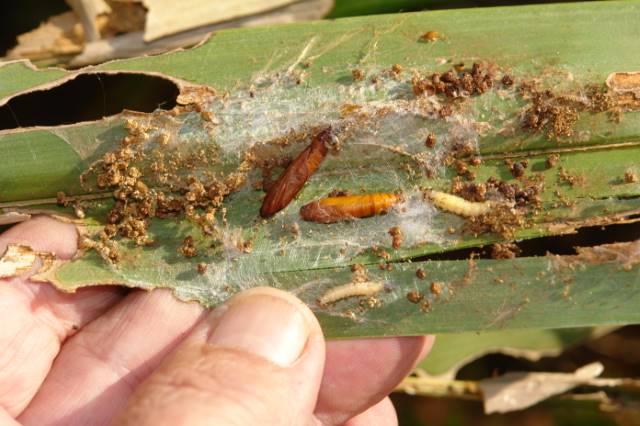
Coconut leafroller (Omiodes blackburni): Unlike the banana moth, this species lays its wings down to look like a triangle and hosts intricate wing patterns. Adult moths will lay eggs on the frond leaflets, which their caterpillars will feed on. This moth is endemic to Hawaiʻi and is believed to have co-evolved with either native banana or Pritchardia species. This native pest is more common in windy areas, which can blow away their tiny natural parasitic enemies.
Sucking Insects
These types of pests are characterized by their piercing or sucking mouthparts and they go through gradual metamorphosis. They begin as eggs and hatch into immature nymphs that look similar to their adult stage. Nymphs gradually get bigger until they finally transition into an adult. Most pests below fall under the Order Hemiptera, which is incredibly diverse including aphids, mealybugs, scales, shield bugs, spittlebugs, leafhoppers, moss bugs and many more. Another category of sucking insects is mites (Order: Acari). Compared to insects, mites have two instead of three body segments, 2-4 pairs of legs instead of the standard three, and mites are always wingless.
Order Hemiptera (True Bugs)
Fiorinia scale (Fiorinia phantasma): An extremely small scale that lives on the underside of palm fronds. Males are beige and females are yellow with red stripes. This pest was first discovered in Hawaiʻi in 2004 and can thrive on palms (especially areca), kamani, shower trees, naio, pandanus, mock orange, and others.
Damage looks like scabbing coloration on the upper leaf surfaces and dusty yellow-beige coating on the lower leaf surfaces. There are natural enemies for this pest, but horticultural oils can be effective during the crawler stage. Systemic insecticides and insect growth regulators are also effective. Check out details and photos in this HDOA Fiorinia phantasma Pest Advisory.


Palm mealybug (Palmicultor palmarum) and coconut mealybug (Nipaecoccus nipae): Mature female mealybugs are white, waxy, and filamentous. Mature males are winged and look like flies. The main species difference is their wax coating pattern. Palm mealybug is horizontally striped while coconut mealybug has pyramid shaped filaments. Both species have a wide host range of palms, ornamentals, and crops.
Damage looks like waxy white fuzz on young fronds and meristems. Black sooty mold on leaf surfaces indicates an infestation due to excess honeydew from mealybugs. Invasive ants farm these pests and protect them from enemies. Black sooty mold decreases plant productivity and may result in defoliation or death. Horticultural oils, insecticidal soaps, systemic insecticides, and insect growth regulators are effective. Read details in these resources: CTAHR Palm Mealybug Factsheet and Pacific Pests & Pathogens Coconut Mealybug Factsheet.
Palm aphid (Cerataphis spp.): The only aphid common on palms and they look more like scales. Adults are 1-2 mm, shiny dark brown, and have a threadlike white fringe. They are also wingless and don’t move much. Immature aphids are greener and can crawl. Palm aphids love coconut palm, ornamental palms, bamboos, pandanus, and orchids.
Damage looks like tiny dark spots coating the palm stem or leaflets. The most noticeable sign is black sooty mold due to excess honeydew from aphids. Black sooty mold decreases plant productivity and may result in defoliation or death. Horticultural oils and insecticidal soaps work well to manage. Read details in this resource: Palm Aphids Factsheet.

Order Acari (Mites)
PLEASE REPORT IF SEEN:
Red palm mite (Raoiella indica): These tiny red mites (1/100th of an inch) attack palms, bananas, beans, and more. Multiple generations can be found feeding on the underside of palm fronds. This pest is wind-dispersed and has been recently detected on Oʻahu and Maui.
Damage looks like yellow spots and blotches on the upper leaf surface due to feeding on underside. Yellowing can become so severe that fronds brown, flowers under develop, and fruits reduce in size. Unlike spider mites, the red palm mite does not produce any silky webbing. You are more likely to see damage on the older fronds and when it’s hot and dry. Read more about this pest in this UF|IFAS Red Palm Mite Factsheet.


Coconut mite (Aceria guerreronis): These mites are microscopic and translucent, which make them easily dispersible by wind, insect, or bird. Coconut mites will live and feed under the coconut perianth, which is where the stem meets the immature fruit. Their populations peak half way through the 12-month coconut fruit development process and then decline once coconuts are mature.
Damage looks like a pale silvery patch growing from the perianth, at first. As the fruit matures, the damaged tissues look similar to cork with deep cracks. Fruit will be deformed, stunted, scarred, or prematurely dropped. If you suspect an infestation, you should prune all stages of coconut fruit from the tree. Read more in this CTAHR Hawaiʻi Landscape Plant Pest Guide.
